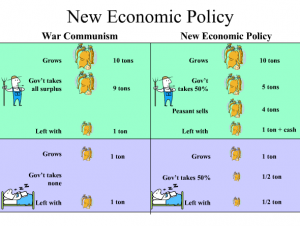As the Russian Civil War (1917-1922) neared its end, Vladimir Lenin and Leon Trotsky sought to utilize the war energy and spirit to help improve the economy. Under their leadership, the Bolsheviks began to convert military units into “labor armies.” The first of these troops to be converted was the Third Red Army, which became the First Labor Army in 1920. The troops new orders, as evidenced by Trotsky’s “Order to the Third Red Army – First Labor Army,” and Lenin’s “Decree on the First Revolutionary Labor Army,” were to help laborers in tasks of carpentry, blacksmithing, and farming. Furthermore, armies and laborers shared food and registered each worker and item produced. Trotsky and Lenin meant for the system to be organized and working within the framework already set up by locals. These orders are filled with Marxist ideology, especially in their valuation of equality, unity, and the spread of knowledge. However, it seems this system did not work as well as Trotsky and Lenin had hoped, because only a year later, Lenin introduced new economic policy.
This “New Economic Policy” (NEP) acted as a significant shift in direction, perhaps best indicated by the chart below.
The biggest change between the old War Communism, and the New Economic Policy was the introduction of a tax-in-kind. According to a document put forth by the All-Russian Central Executive Committee, the tax-in-kind was percentage-based, progressive, and precisely timed.[2] After the government collected the tax, laborers could use the surplus for consumption and exchange, or trading with the government for other items of consumption and agricultural machinery.
In other documents, such as the “All-Russian Central Executive Committee, The Right of Private Property in Commerce and Industry” and “Law on Land Tenure and Use. May 22, 1922,” Lenin especially utilized and emphasized a rational system. The documents meticulously lay out what items could be considered private property and what could be contracted.[3] They also specifically attend to landowning, and the types of land-tenure an agricultural community could have.[4] In allowing a community to elect which type of land-tenure to use, the law enabled the laborers to choose. Furthermore, the documents dictate that if one is unable to fulfill their duty, they will be able to hire help, or if one enters the military, the community will take care of the land for him/her. However, the documents appear a little too idealistic in their expectations for people to think rationally, and perhaps this is why Stalin retracts many of the policies in 1929.
[1] Comparison Between War Communism and the New Economic Policy. Digital image. The New Economic Policy. Evaluate. Accessed February 14, 2016. https://isemodernworldhistorygrade9.wikispaces.com/The New Economic Policy. Evaluate.
[2]V. I. Lenin, “All-Russian Central Executive Committee, The Tax in Kind. March 21, 1921,” Collected Works (New York: International Publishers, 1934), Vol. XXXII, pp. 214-228.
[3] “All-Russian Central Executive Committee, The Right of Private Property in Commerce and Industry. May 22, 1922,” Russian Information and Review. Vol. I, No. 20 (15 July 1922), pp. 478-479.
[4] J. Meisel and E. S. Kozera, eds., “Law on Land Tenure and Use. May 22, 1922,” Materials for the Study of the Soviet System (Ann Arbor: G. Wahr Pub. Co., 1953), pp. 133-138.


What I found particularly striking in “All-Russian Central Executive Committee, The Right of Private Property in Commerce and Industry” was the statement that any contract “whose object [was] to defeat the law” was considered invalid. The document does not define how the government would prove this objective to defeat the law. Even if an individual contract never intended on defeating the law, the government determined what the object was, leaving very little room for argument. Though this sentence does provide necessary safety against illegal contracts, it erases any possibility for individual citizens to challenge the law because the government has the authority to define these “challenges” and it does not tolerate them in any way.
I found the Idea that the Soviet Government could recognize the failings of there economy and in an attempt to fix it turned to the largest industrial force that they had access to; The Red Army. It is ironic that an army based on its lack of ranks and the idea that no one was in charge of another was being given orders. The registration of workers and capital is the beginning of the common censuses that is seen in Soviet History.